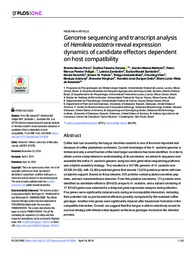Genome sequencing and transcript analysis of Hemileia vastatrix reveal expression dynamics of candidate effectors dependent on host compatibility.
Genome sequencing and transcript analysis of Hemileia vastatrix reveal expression dynamics of candidate effectors dependent on host compatibility.
Autoria: PORTO, B. N.; CAIXETA, E. T.; MATHIONI, S. M.; VIDIGAL, P. M. P.; ZAMBOLIM, L.; ZAMBOLIM, E. M.; DONOFRIO, N.; POLSON, S. W.; MAIA, T. A.; CHEN, C.; ADETUNJI, M.; KINGHAM, B.; DALIO, R. J. D.; RESENDE, M. L. V. de
Resumo: Coffee leaf rust caused by the fungus Hemileia vastatrix is one of the most important leaf diseases of coffee plantations worldwide. Current knowledge of the H. vastatrix genome is limited and only a small fraction of the total fungal secretome has been identified. In order to obtain a more comprehensive understanding of its secretome, we aimed to sequence and assemble the entire H. vastatrix genome using two next-generation sequencing platforms and a hybrid assembly strategy. This resulted in a 547 Mb genome of H. vastatrix race XXXIII (Hv33), with 13,364 predicted genes that encode 13,034 putative proteins with transcriptomic support. Based on this proteome, 615 proteins contain putative secretion peptides, and lack transmembrane domains. From this putative secretome, 111 proteins were identified as candidate effectors (EHv33) unique to H. vastatrix, and a subset consisting of 17 EHv33 genes was selected for a temporal gene expression analysis during infection. Five genes were significantly induced early during an incompatible interaction, indicating their potential role as pre-haustorial effectors possibly recognized by the resistant coffee genotype. Another nine genes were significantly induced after haustorium formation in the compatible interaction. Overall, we suggest that this fungus is able to selectively mount its survival strategy with effectors that depend on the host genotype involved in the infection process.
Ano de publicação: 2019
Tipo de publicação: Artigo de periódico
Unidade: Embrapa Café
Observações
1 - Por padrão são exibidas publicações dos últimos 20 anos. Para encontrar publicações mais antigas, configure o filtro ano de publicação, colocando o ano a partir do qual você deseja encontrar publicações. O filtro está na coluna da esquerda na busca acima.
2 - Para ler algumas publicações da Embrapa (apenas as que estão em formato ePub), é necessário ter, no celular ou computador, um desses softwares gratuitos. Sistemas Android: Google Play Livros; IOS: iBooks; Windows e Linux: software Calibre.
Acesse outras publicações
Acesse a Base de Dados da Pesquisa Agropecuária (BDPA) para consultar o acervo completo das bibliotecas da Embrapa.

